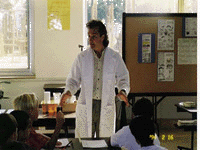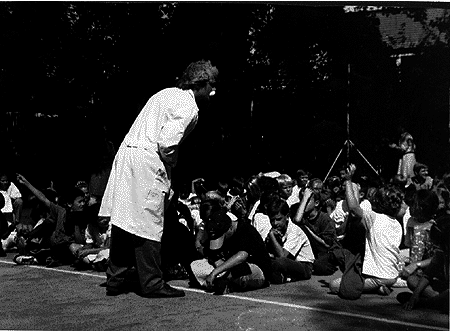| Workings of the Program | |||||||||||
| Sharing Science | |||||||||||
| Kids Teaching Kids | |||||||||||
| On-Line Physics | |||||||||||
| Enrichments | |||||||||||
| Collaboratives | |||||||||||
If you would like any information on these or other collaborative programs please use the following e-mail address: send mail to kskrutvold@uswest.net.



"Be An Einstein....Ask
Why?"
The "Be an Einstein....Ask Why?" program was developed and implemented to create the interactive sharing of science between elementary first graders and high school physics students. Elementary Students ask specific science questions, from general to specific concepts, of my physics students. It is then the task of my high school physics students to answer these questions through the use of drawings, models, demonstrations, or laboratory experiences. The method of answering the questions must be done creatively, so that the elementary students can understand and visualize the responses. As a result of trying to develop age-appropriate answers, the physics students oftentimes are involved in the assembly of simple, inexpensive demonstrations and lab set-ups for active use in the elementary classrooms.
An important aspect of this activity was the enhancement of the physics students' skills in adapting materials and equipment for use in the answering of the questions. Our suggestion to utilize visual methods was made to ensure that both the physics and elementary students had a clear understanding of the concepts used in answering the questions that were asked. It should be noted that many of the physics students had little or no previous experiences working creatively within a framework of this type. This part of the activity became a real confidence-builder for my physics students.
The physics students receive varied suggestions from Ms. Edward and myself to optimize a variety of methods in answering the questions, but under most circumstances they were left to their own devices to provide the appropriate answers. This provided the opportunity to creatively develop; build, test and prepare the answers for themselves.
The program challenges students at both levels to be curious, rather than just looking something up in a resource or textbook and writing down what is observed.
Once the elementary students receive their answers, the elementary teacher reinforces the answers with demonstrations or hands-on activities received from my high school students. Once the answers have been presented, the elementary students are allowed to try the demonstrations or labs themselves. On many occasions the younger children ask if they can bring the materials home to show their parents, so the whole family becomes involved. A component of the program that should not go unmentioned is that the questions asked are in most cases from specific individuals, therefore, the answers presented to them are personalized in letter or narrative form to that particular student from the physics students at the high school. This personalizes the connection between the elementary students and high school students.
The "Be an Einstein....Ask Why?" program had been integrated throughout the physics curriculum and Ms. Edward's science curriculum at the International School of Prague. It continually provides the hands-on discovery of real-world connections for the physics students, as well as the elementary students. The program has resulted in multiple benefits for students of all ages. It has created a non-threatening atmosphere for students to be heavily involved in interactive projects in and outside of the classroom; it has provided a special two-way channel of learning among students that is seldom achieved anywhere else in the academic setting; and it allows for the use of real life as a lab. The program challenges students to be curious; to actively participate in looking for connections, rather than just seeing a reference in a textbook or resource. Students from kindergarten through the senior class have enjoyed the "Sharing of Science" with fun and exciting activities.
The "Be an Einstein....Ask Why?" program has allowed for the increased communication between elementary and secondary schools through ongoing feedback and ownership for the students and teachers involved in the program. Ms. Edward and I are currently teaching at Taipei American School in Taipei, Taiwan, which has brought yet another dimension to our program. Currently our school has student representation from 43 different countries around the world. It's apparent that we have a very diverse group of individuals with many varied backgrounds and personalities. The student population involved in the High School program is certainly representative of cultural and nationality differences and this has brought a real global perspective to the activities undertaken. In order to allow for the camaraderie and cohesiveness of the group, the physics students are divided into two and three member teams. The physics teams are altered throughout the academic year and became strong support mechanisms for one another. This part of the program became a pleasant surprise for me, to see my physics students meet regularly among themselves without any coercive persuasion or prodding from me. A learning environment developed to include students helping each other in all aspects of their school lives. The classroom atmosphere became one of mutual acceptance because the physics teams were involved in a collaborative learning experience.
The physics students' expectations of the program was initially one of apprehension and excitement at the same time. Images of wide-eyed children attentively listening and receiving their responses from Ms. Edward, their teacher, thinking back and reflecting on their frustration in trying to develop appropriate demos or answers to some very sophisticated questions, reminiscences of feverishly trying to meet impending deadlines. These pictures, and so many more like them, combined to make the program a success. The students went a long way from the hesitant students they were at the beginning of the year to very composed and accomplished physics learners. The students felt good about themselves weekly and they developed a special pride in their classmates as they all developed their responses and demos for the elementary students. They were all in the program together, and they could share their experiences and empathize with each other throughout the year. It certainly made physics and science more palatable for students that are often lost in the cracks of educational systems.